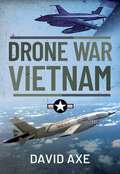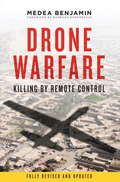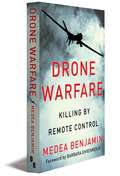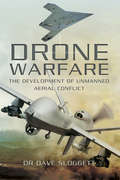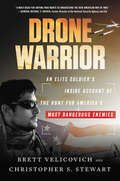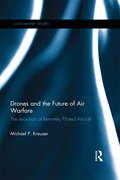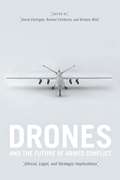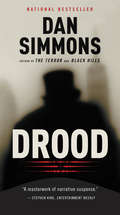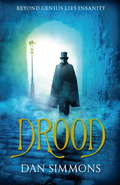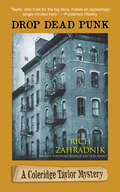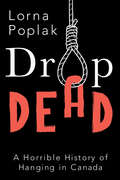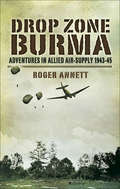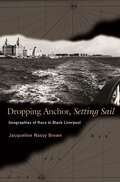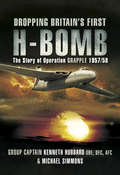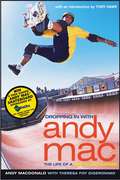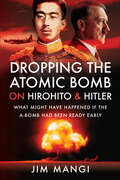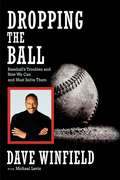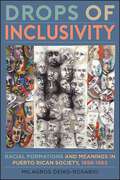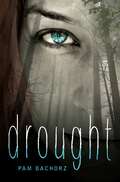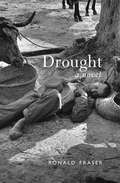- Table View
- List View
Drone War Vietnam
by David AxeWhile the use of drones is now commonplace in modern warfare, it was in its infancy during the Vietnam War, not to mention revolutionary and top secret. Drones would play an important – and today largely unheralded – role in the bloody, two-decade US air war over Vietnam and surrounding countries in the 1960s and ’70s. Drone aircraft spotted targets for manned US bombers, jammed North Vietnamese radars and scattered propaganda leaflets, among other missions. This book explores that obscure chapter of history. DRONE WAR: VIETNAM is based on military records, official histories and published first-hand accounts from early drone operators, as well as on a close survey of existing scholarship on the topic. In their fledgling efforts to send robots instead of human beings on the most dangerous aerial missions, US operators in South-East Asia in the 1960s and ’70s wrote the first chapter in the continuing tale of autonomous warfare.
Drone Warfare
by Barbara Ehrenreich Medea BenjaminDrone Warfare is the first comprehensive analysis of one of the fastest growing--and most secretive--fronts in global conflict: the rise of robot warfare. In 2000, the Pentagon had fewer than fifty aerial drones; ten years later, it had a fleet of nearly 7,500, and the US Air Force now trains more drone "pilots" than bomber and fighter pilots combined. Drones are already a $5 billion business in the US alone. The human cost? Drone strikes have killed more than 200 children alone in Pakistan and Yemen.CODEPINK and Global Exchange cofounder Medea Benjamin provides the first extensive analysis of who is producing the drones, where they are being used, who controls these unmanned planes, and what are the legal and moral implications of their use. In vivid, readable style, this book also looks at what activists, lawyers, and scientists across the globe are doing to ground these weapons. Benjamin argues that the assassinations we are carrying out from the air will come back to haunt us when others start doing the same thing--to us.
Drone Warfare: Killing by Remote Control
by Barbara Ehrenreich Medea BenjaminWeeks after the 2002 American invasion of Afghanistan, Medea Benjamin visited that country. There, on the ground, talking with victims of the strikes, she learned the reality behind the "precision bombs" on which U. S. forces were becoming increasingly reliant. Now, with the use of drones escalating at a meteoric pace, Benjamin has written this book as a call to action: "It is meant to wake a sleeping public," she writes, "lulled into thinking that drones are good, that targeted killings are making us safer. " Drone Warfare is a comprehensive look at the growing menace of robotic warfare, with an extensive analysis of who is producing the drones, where they are being used, who "pilots" these unmanned planes, who are the victims and what are the legal and moral implications. In vivid, readable style, the book also looks at what activists, lawyers and scientists are doing to ground the drones, and ways to move forward. In reality, writes Benjamin, the assassinations we are carrying out via drones will come back to haunt us when others start doing the same thing--to us.
Drone Warfare: The Development of Unmanned Aerial Conflict
by Dr. Dave SloggettThe Development of Unmanned Aerial Conflict will examine the development and use of aerial drones, a topical subject that has not been written on to date.An unmanned aerial vehicle, commonly known as a drone, is an aircraft without a human pilot on board. Its flight is either controlled autonomously by computers in the vehicle, or under the remote control of a navigator or pilot on the ground or in another vehicle.Blending history with current and recent operations, Dr Sloggett will set out to put the record straight. In some quarters of the press drones get a bad press and there has been much controversy over their deployment, some of which is not deserved.The book reveals the history of unmanned aircraft, their recent development and why they have emerged onto the scene. Why did the US, for example, really invest highly in drone technology? When did all that start? What barriers had to be overcome? What was there before drones arrived?The book also analyses their operations in Iraq in Gulf War Two and more recently Afghanistan. What roles did drones play? Where they successful? What new developments emerged during operations? Did they save lives? Further to this is a detailed look at case studies where they have been used trying to remove some of the incorrect reporting – putting the record straight based on evidence. How many have been shot down and where?The book then looks at strategic uses of drones at present: Iran is being monitored; they are already in action over parts of Africa; what are other countries doing – China, Iran? Turkey?The RAF's use of drones, their deployment and operations is considered along with important questions such as where this goes for the future. What are the issues? Will all air forces be drone based in the future? What other applications may arise in the civilian market?
Drone Warrior: An Elite Soldier's Inside Account of the Hunt for America's Most Dangerous Enemies
by Christopher S. Stewart Brett VelicovichA former U.S. Army intelligence and special ops soldier gives a look inside some of the nation’s most secretive military operations.For nearly a decade, Brett Velicovich was at the center of America’s new generation of warfare: an arsenal of unmanned aerial vehicles—drones—taking down the world’s deadliest terrorists across the globe. Now this decorated veteran, with journalist Christopher S. Stewart, tells his story in a remarkable book packed with more classified drone operations cleared for public release than any other account ever published, according to the U.S. government. Drone Warrior offers an unprecedented view into the remarkably complex nature of drone missions in the hottest conflict zones today and the rigorous and wrenching on-the-ground decisions behind them.Drone Warrior also chronicles the U.S. military’s evolution in the past decade and the technology driving it. Velicovich considers the future it foretells, and speaks candidly on the physical and psychological toll it exacts, including the impact his missions had on his own life. He reminds us that while these machines can kill, they can also be used to preserve life, including protecting endangered species and supporting humanitarian operations—work he is engaged in today.
Drone Wars
by Peter L. Bergen Daniel RothenbergDrones are the iconic military technology of many of today's most pressing conflicts. Drones have captured the public imagination, partly because they project lethal force in a manner that challenges accepted norms and moral understandings. Drone Wars presents a series of essays by legal scholars, journalists, government officials, military analysts, social scientists, and foreign policy experts. It addresses drones' impact on the ground, how their use adheres to and challenges the laws of war, their relationship to complex policy challenges, and the ways they help us understand the future of war. The book is a diverse and comprehensive interdisciplinary perspective on drones that covers important debates on targeted killing and civilian casualties, presents key data on drone deployment, and offers new ideas on their historical development, significance, and impact on law and policy.
Drones and the Future of Air Warfare: The Evolution of Remotely Piloted Aircraft (Cass Military Studies)
by Michael P. KreuzerThis book examines the evolution of airpower and specifically the growth and proliferation of Remotely Piloted Aircraft (RPAs). While most existing literature examines either the law or ethics of RPAs, and some newer scholarship looks to the battlefield effectiveness (the gains from strikes versus the potential for ‘blowback, etc.), this work investigates it from a broader military perspective. It examines the strategy for employment of RPAs across the spectrum of warfare, the potential deterrent value of RPAs in some circumstances, and the resulting ability of RPAs to fundamentally shift the character of when and how wars are fought. The central aim of this book is to evaluate the role of ‘drones’ in warfare to date, and make basic projections on how states will adopt RPAs and UCAVs in the future. At the core is the goal of answering a broad, underlying research question: How will the RPA innovation impact military strategy and international security? This book will be of much interest to students of airpower, drone warfare, military and strategic studies, security studies and IR.
Drones and the Future of Armed Conflict: Ethical, Legal, and Strategic Implications
by Rachel Fairhurst Kristen Wall David Cortright, Rachel Fairhurst, and Kristen WallDuring the past decade, armed drones have entered the American military arsenal as a core tactic for countering terrorism. When coupled with access to reliable information, they make it possible to deploy lethal force accurately across borders while keeping one’s own soldiers out of harm’s way. The potential to direct force with great precision also offers the possibility of reducing harm to civilians. At the same time, because drones eliminate some of the traditional constraints on the use of force—like the need to gain political support for full mobilization—they lower the threshold for launching military strikes. The development of drone use capacity across dozens of countries increases the need for global standards on the use of these weapons to assure that their deployment is strategically wise and ethically and legally sound. Presenting a robust conversation among leading scholars in the areas of international legal standards, counterterrorism strategy, humanitarian law, and the ethics of force, Drones and the Future of Armed Conflict takes account of current American drone campaigns and the developing legal, ethical, and strategic implications of this new way of warfare. Among the contributions to this volume are a thorough examination of the American government’s legal justifications for the targeting of enemies using drones, an analysis of American drone campaigns’ notable successes and failures, and a discussion of the linked issues of human rights, freedom of information, and government accountability.
Drood: A Novel
by Dan SimmonsOn June 9, 1865, while traveling by train to London with his secret mistress, 53-year-old Charles Dickens--at the height of his powers and popularity, the most famous and successful novelist in the world and perhaps in the history of the world--hurtled into a disaster that changed his life forever. Did Dickens begin living a dark double life after the accident? Were his nightly forays into the worst slums of London and his deepening obsession with corpses, crypts, murder, opium dens, the use of lime pits to dissolve bodies, and a hidden subterranean London mere research ... or something more terrifying? Just as he did in The Terror, Dan Simmons draws impeccably from history to create a gloriously engaging and terrifying narrative. Based on the historical details of Charles Dickens's life and narrated by Wilkie Collins (Dickens's friend, frequent collaborator, and Salieri-style secret rival), DROOD explores the still-unsolved mysteries of the famous author's last years and may provide the key to Dickens's final, unfinished work: The Mystery of Edwin Drood. Chilling, haunting, and utterly original, DROOD is Dan Simmons at his powerful best.
Drood: from the bestselling author of The Terror
by Dan Simmons Quercus'I am in awe of Dan Simmons' Stephen KingIn 1865 Charles Dickens, the world's most famous writer, narrowly escapes death in the Staplehurst Rail Disaster. He will never be the same again. A public hero for rescuing survivors, he slowly descends into madness as he hunts the individual he believes to be responsible for the carnage: a spectral figure known only as Drood.His best friend, Wilkie Collins, is enlisted for the pursuit. Together they venture into Undertown, the shadowy, lawless web of crypts and catacombs beneath London. Here Drood is rumoured to hold sway over a legion of brainwashed followers. But as Wilkie spirals ever further into opium addiction and jealousy of the more successful novelist, he must face a terrifying possibility: is Charles Dickens really capable of murder?Readers are loving Drood'Beautifully written, fiction heaven!' *****'One of my favourite reads ever' *****'A masterpiece' *****'Epic adventure' *****'Surprising - I enjoyed every page' *****
Drop Dead
by Richard E. FarleyA Simon & Schuster eBook. Simon & Schuster has a great book for every reader.
Drop Dead Punk (The Coleridge Taylor Mysteries #2)
by Rich ZahradnikTake a step back into 1970s New York City in a hard-edged murder mystery sequel to Last Words featuring “an appealingly single-minded hero” (Publishers Weekly). Intrepid reporter Coleridge Taylor is searching for his next scoop now that he’s back on the Messenger-Telegram police beat. Both the city and Coleridge are on the edge of financial ruin, but he finally catches a break when a source sends him down to Alphabet City where the punk rock ruffians hang out. There he finds two dead bodies after a mugging gone bad: one a punk, one a cop. But the story doesn’t add up. The punk was actually a good kid. And the cop’s female partner, Officer Samantha Callahan, is being blamed for his death. She insists she was called away, but the NYPD wants to throw her to the wolves. Immediately smitten, Coleridge decides to help the beauty in blue. But the more he falls for Samantha, the more dangerously close he gets to his story. Because Officer Callahan has just become a target—and Coleridge is standing between her and some awfully big guns.
Drop Dead: A Horrible History of Hanging in Canada
by Lorna PoplakShining a light on the dark history of hangings in Canada. Take a journey through notable cases in Canada’s criminal justice history, featuring well-known and some less-well-known figures from the past. You'll meet Arthur Ellis, Canada’s most famous hangman, whose work outfit was a frock coat and striped trousers, often with a flower pinned to his lapel. And you will also encounter other memorable characters, including the man who was hanged twice and the gun-toting bootlegger who was the only woman every executed in Alberta. <p><p> Drop Dead: A Horrible History of Hanging in Canada illustrates how trial, sentencing, and punishment operated in Canada’s first century, and examines the relevance of capital punishment today. Along the way, learn about the mathematics and physics behind hangings, as well as disturbing facts about bungled executions and wrongful convictions.
Drop Zone Borneo: Life and Times of an RAF Co-Pilot Far East, 1962-65
by Roger AnnettIn 1963 the Indonesian Army that threatened Borneo numbered 330,000 men, plus three thousand Commandos. Of these, six thousand were within 20 miles of the Borneo frontier. This grew to thirteen thousand in early 1965. From mid-way through 1964, British troops and their allies who were defending the border started to make offensive incursions into Indonesian Borneo—these operations were codenamed "Claret". Taken into account the confrontational nature of the campaign, casualties sustained in Borneo were surprisingly light. That in the whole of the Borneo campaign there were no fatalities among the RAF supply-dropping transports was extraordinary. The border area between the Indonesian and Malaysian parts of Borneo was one of the most inaccessible areas of mountainous jungle anywhere in the world—an entire army was kept supplied in the field for the complete campaign. This is the exciting account from a pilot who flew the dangerous flying missions and relates the tenseness and stresses of Jungle life in those dangerous days.
Drop Zone Burma: Adventures in Allied Air-Supply, 1943–45
by Roger AnnettAir-dropped supplies were a vital part of the Allied campaign in Burma during World War II. The transportation of munitions, food and medical supplies was undertaken in the most difficult situations, both on the land where the air bases were often situated in remote tropical jungle terrain and in the air when hazardous flying conditions were met in the steamy airs above the carpet of forest treetops.This book is based upon the memories of nine veterans of the campaign: John Hart, an air-dispatcher with 194 Squadron; Peter Bray, a Dakota pilot with 31 Squadron; Arthur Watts, a fitter with both 31 and 194 Squadrons; Colin Lynch an Observer on 31 Squadron; Norman Currell, a Dakota pilot with 31 Squadron; George Hufflett, 1st Queens Infantry; Ken Brown, Royal Signals; Eric Knowles, the Buffs and Dame Vera Lynn who was with ENSA during the campaign. It describes how they arrived in Burma and their previous wartime experiences and then explains there parts in the famous actions such as The Defence of Arakan, The Sieges of Imphal and Kohima, the Allied Counterattack, the Advance to Mandalay and the Race to Rangoon.The author explains the background to this theater of war and then puts the veterans memories into context as the campaign progresses.
Dropping Anchor, Setting Sail: Geographies of Race in Black Liverpool
by Jacqueline Nassy BrownThe port city of Liverpool, England, is home to one of the oldest Black communities in Britain. Its members proudly date their history back at least as far as the nineteenth century, with the global wanderings and eventual settlement of colonial African seamen. Jacqueline Nassy Brown analyzes how this worldly origin story supports an avowedly local Black politic and identity--a theme that becomes a window onto British politics of race, place, and nation, and Liverpool's own contentious origin story as a gloriously cosmopolitan port of world-historical import that was nonetheless central to British slave trading and imperialism. This ethnography also examines the rise and consequent dilemmas of Black identity. It captures the contradictions of diaspora in postcolonial Liverpool, where African and Afro-Caribbean heritages and transnational linkages with Black America both contribute to and compete with the local as a basis for authentic racial identity. Crisscrossing historical periods, rhetorical modes, and academic genres, the book focuses singularly on "place," enabling its most radical move: its analysis of Black racial politics as enactments of English cultural premises. The insistent focus on English culture implies a further twist. Just as Blacks are racialized through appeals to their assumed Afro-Caribbean and African cultures, so too has Liverpool--an Irish, working-class city whose expansive port faces the world beyond Britain--long been beyond the pale of dominant notions of authentic Englishness. Dropping Anchor, Setting Sail studies "race" through clashing constructions of "Liverpool."
Dropping Britain's First H-Bomb: The Story of Operation GRAPPLE, 1957/58
by Michael Simmons Kenneth HubbardOn 15 May 1957 Vickers Valiant V-Bomber X.D.818 under the command of Wg. Cdr. Kenneth Hubbard, O.C. 49 Squadron R.A.F., dropped Britains first live thermonuclear bomb. The success of Operation Grapple broadcast to the world that the UK had the resolve and the capability to protect her own democracy and that of her Commonwealth. It was a major breakthrough that ensured Britain maintained her place in the most senior influential positions of the United Nations and other corridors of world power, and in the ensuing years provide Britains deterrent throughout the decades of the Cold War.The theme of this book is to explain how the R.A.F. selected and trained the crews who would be responsible for the precision dropping of the several weapons that would detonate during Grapple. It also provides a complete background to the parts played by all other services during this unique period in British history.
Dropping in with Andy Mac
by Theresa Foy Digeronimo Lauren Monchik Andy MacdonaldAs a baby he flipped himself upside down in his jolly jumper. As a kid he rode his Big Wheel into traffic. When he discovered skateboarding, his life was changed forever. So how did Andy Macdonald go from death-defying stunts in his jolly jumper to world champion skateboarder? In his own words, Andy shares all the ups and downs and the spills and thrills, from driving to California in a broken-down car and dressing up as Shamu at Sea World to setting world records and giving a speech at the White House. He's traveled the world over with his skateboard under his arm. Andy's made the road to sweet, sweet success look easy. But this behind-the-scenes look takes you onto the platform of the vert ramp -- to the competitions, the long hours of practice, and more. It reveals a bumpy road to the top that, as Andy will tell you, could be reached only with the guts that skateboarding gave him.
Dropping in with Andy Mac
by Theresa Foy Digeronimo Lauren Monchik Andy MacdonaldAs a baby he flipped himself upside down in his jolly jumper.As a kid he rode his Big Wheel into traffic.When he discovered skateboarding,his life was changed forever.So how did Andy Macdonald go from death-defying stunts in his jolly jumper to world champion skateboarder? In his own words, Andy shares all the ups and downs and the spills and thrills, from driving to California in a broken-down car and dressing up as Shamu at Sea World to setting world records and giving a speech at the White House. He's traveled the world over with his skateboard under his arm. Andy's made the road to sweet, sweet success look easy. But this behind-the-scenes look takes you onto the platform of the vert ramp -- to the competitions, the long hours of practice, and more. It reveals a bumpy road to the top that, as Andy will tell you, could be reached only with the guts that skateboarding gave him.
Dropping the Atomic Bomb on Hirohito & Hitler: What Might Have Happened if the A-Bomb Had Been Ready Early
by Jim MangiOn 2 August 1939, the renowned theoretical physicist Albert Einstein wrote a letter to President Roosevelt in which he declared that ‘it might become possible to set up a nuclear chain reaction in a large mass of uranium’. He went on to declare that ‘extremely powerful bombs of a new type may thus be constructed’. Shortly after Japan’s attack on Pearl Harbor, Congress allocated substantial funds to allow research to be undertaken to follow through on Einstein’s idea and build an atomic bomb. Few, if any, could have imagined what they had agreed to support. But what if actual events had taken a different course? The First Atomic Bomb: An Alternate History to the Ending of WW2 is a highly accurate, thoroughly researched, alternative history presenting a narrative of events exploring what might have happened if the atom bomb had been available somewhat earlier than it really was. What if the atomic bomb had been ready for deployment in, say, February 1945? Had the atomic bomb been ready sooner, how would this have affected the war in Europe, and in particular Germany’s surrender? What would the impact have been in the war in the Pacific against Imperial Japan, and how would the Soviets have reacted? And what would the following Cold War have looked like? These are all questions and scenarios that the author rigorously examines. Solidly based on real people and actual events, in this book James Mangi describes the Manhattan Project to build the atom bomb getting an earlier start after President Roosevelt appointed an energetic scientist, Walter Mendenhall, to study the feasibility of the bomb, instead of the more traditional bureaucrat, Lyman Briggs, he actually chose. This scenario, he reveals, might well have produced a war-ending atomic bomb earlier, the effects of which rippled through the post-war world.
Dropping the Ball: Baseball's Troubles and How We Can and Must Solve Them
by Dave Winfield Michael LevinHALL OF FAMER DAVE WINFIELD: "THE GAME I LOVE IS HURTING." Revenue has never been higher, attendance has never been better, and baseball has never had a stronger international presence. Yet, with all of the prosperity, the game has rarely faced more significant problems, both in the headlines and deep within our communities. Steroid scandals, labor strife, self-centered superstars, a dramatic decline in the number of African American players and fans, constraints on Little League facilities and resources, and competition from trendier sports and entertainment options all threaten the foundations of our national pastime. Dave Winfield knows and loves the game and he believes baseball can be rescued and revitalized. In Dropping the Ball, Dave presents his compelling plan of action for saving this great game from self-destruction. A respected role model and ambassador of the sport, Winfield outlines his strategy for making baseball the game he knows it can be: inclusive, empowering, and entertaining. He focuses on how to make the game more fan-friendly, and especially how to reach out to the African American community. From the commissioner's office to the kids on the street, Winfield examines the game from every perspective, offering ideas and solutions for diversifying front offices; marketing the game; developing community-based programs; and working out fair, creative, and lucrative parameters for the business of baseball. Dropping the Ball inspires readers to get out of the armchair and into the action. Urbane and entertaining, this is a trenchant, thought-provoking, and uplifting analysis of what can be done -- by the baseball giants and by all who play and love the game -- to save America's national pastime for you, your kids, and your community.
Drops of Inclusivity: Racial Formations and Meanings in Puerto Rican Society, 1898-1965 (SUNY series, Afro-Latinx Futures)
by Milagros Denis-RosarioDrops of Inclusivity examines race and racism on the island of Puerto Rico by combining a wide-angle historical narrative with the individual stories of Black Puerto Ricans. While some of these Afro-Boricuas, such as Roberto Clemente and Ruth Fernández, are well known, others, such as Cecilia Orta and Juan Falú Zarzuela, have been largely forgotten, if remembered at all. Individually and collectively, their words and lives speak to the persistent power of racial hierarchies and responses to them across periods, from the Spanish-American War at the turn of the twentieth century to Martin Luther King, Jr.'s visit to the island in the early 1960s. Drawing on rich archival research, Milagros Denis-Rosario shows how Afro-Boricuas denounced, navigated, and negotiated racism in the fields of education, law enforcement, literature, music, the military, performance, politics, and more. Each instance of self-determination marks a gain in inclusivity—gota a gota, or drop by drop, as the saying goes in Puerto Rico. This study pays homage to them.
Dropsy, Dialysis, Transplant: A Short History of Failing Kidneys (Johns Hopkins Biographies of Disease)
by Steven J. PeitzmanSmall and bean shaped, the kidneys are sophisticated organs that filter waste from the blood. A number of diseases and disorders—including diabetes and hypertension—can harm the kidneys and cause them to fail.Historian and nephrologist Steven J. Peitzman traces the medical history of kidney disease alongside the personal experience of illness. Drawing on diaries, letters, literary narratives, and scientific writings, Peitzman charts the triumphs of medical innovators like Richard Bright, Thomas Addis, and Belding Scribner as well as the stories of persons, famous and not, who have struggled with the disease. Conditions once known as "Bright’s Disease" are now recognized as complex disorders with names such as glomerulopathy and acute tubular necrosis. Treatments have evolved from abdominal tapping and dietetics to hemodialysis and transplantation. Medical advances have improved the well-being and prognosis of persons with failing kidneys. Yet such persons continue on an arduous journey of chronic illness. Peitzman travels with them, from diagnosis to treatment, and witnesses their remarkable ability to cope.Joining the clinician’s perspective with the historian’s analysis, this fascinating chronicle offers insight into how diseases are defined, categorized, and understood and explains current concepts of how kidney disease behaves and how modern therapy works.
Drought
by Pam BachorzA young girl thirsts for love and freedom, but at what cost? Ruby dreams of escaping the Congregation. Escape from slaver Darwin West and his cruel Overseers. Escape from the backbreaking work of gathering water. Escape from living as if it is still 1812, the year they were all enslaved. When Ruby meets Ford—an irresistible, kind, forbidden new Overseer—she longs to run away with him to the modern world where she could live a normal teenage life. Escape with Ford would be so simple. But if Ruby leaves, her community is condemned to certain death. She, alone, possesses the secret ingredient that makes the water so special—her blood—and it's the one thing that the Congregation cannot live without. Drought is the haunting story of one community's thirst for life, and the dangerous struggle of the only girl who can grant it.
Drought
by Ronald FraserA brilliant novel about memory, love, and the clash between the old world and the new, set in 1950s Spain "He turned his back on the old man to mourn in silence this unnecessary death and his part in it; but the sight of the coffin brought anger instead ..."In 1957, a burned-out British journalist leaves London to recuperate in the idyllic Andalusian village of Benalamar, a place little changed since the tumult of Spain's civil war. But when a foreign businessman arrives with plans to develop the area, the community is thrown into turmoil. During a time of drought, the promise of a reservoir is meant to allay the fears of the local populace, but the developer has little idea what he is playing with. A local farmer commits suicide, and the investigation that follows leads back into recent history, lost love and civil war - all a far cry from the tranquil retreat that once promised respite from a world of lurid headlines and backroom shenanigans.Drought is a keenly felt novel about memory, love and the clash between the old world and the new.From the Trade Paperback edition.
